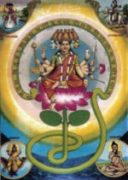Atharva veda Atharvana veda
Atharva Veda consists of 5987 hymns composed into 73 Suktas. Etymologically there areso many speculations about the origin of word Atharvana Veda. Some delete ‘na’ from word Atharvana and call it simply as Atharva Veda. Reasons are not known for doing this. But from one angle word Atharva is near to word Athvaryu, may be, father of Vedas. (The following texts are extracts from Chapter 2, Vedic Literature in author’s BOOK: “A Tribute to the Ancient World of India”)
And some say that this word Atharvana is an amalgamation of names of the two sages, Athvaryu and Angiras. Athvaryu + Angiras = Athvaryangiras = Atharvana. And let us consider the following proposition also,
AthaH + Vana = Atharvana. AthaH means ‘this’, and Vana means ‘forests’. So meaning of Atharvana Veda should be understood as product of the toil of Rushis living in Forests, the hermits.
Contents of Atharvana Veda are varying and wide ranging. It is just like an encyclopedia of the ancient world. If we read Atharvana veda we would know that the AV is not simply a veda of Charms, magic spells and incantations as believed to be. It covers all fields of study from Theology to Sociology to Astrology or Astronomy to Political science to War and what not?
Watch my Videos on YouTube channel
And another aspect is that Atharvana Veda is not considered as Veda by some people. They would give reason to the fact that Atharva veda hymns are not recited during the conduct of Yajnas. However, it is also a fact that 30% of Rig Vedic and Atharva vedic hymns are same. And I think Sage Veda Vyasa must have categorised Vedic hymns into those which should be chanted during Vedic rituals and those which should become treasures of knowledge. It must be remembered that Ancient Doctors Sushruta and Charaka both claimed that they got their knowledge of medicine from Atharvana Veda. I have found that Atharvana veda is full of materials belonging to Statecraft, Social norms, War art, etc., So Atharvana Veda should be rightly called as Encyclopedia Vedica. …..
TIME AND ASTRONOMY:
Time and astronomy is dealt with in AV in a vivid and meticulous manner,
संवत्सरॊ रथः परिवत्सरॊ रथॊपस्थॊ विराडीषाग्नी
रधमुखम । इन्द्रः सव्तष्टाश्चंद्रमाः सारधिः
saMvatsarO rathaH parivatsarO rathOpasthO viraaDIShaagnI
radhamukham | indraH savtaShTaaScaMdramaaH saaradhiH
(SlOka 2229, sUkta -8, kaaMDa 8, bhRugvaMgiraa RuShi)
Meaning: “Fire god is the face of chariot of a solar Year and moon is the Charioteer.” This clearly envisages that by the time of composition of Vedas itself the grand integration of aspects of Solar and Lunar calendars took place in India.
षडाहु शीतान षडु मास उष्णानृतुं नॊ ब्रूत यतमॊ तिरिक्तः
सप्त सुपर्णाः कवयॊ नि षॆधुः सप्त च्छन्दांस्यनु सप्त दीक्षाः
ShaDAhu SItAn ShaDu mAsa uShNAnRutuM nO brUta yatamO tiriktaH
sapta suparNAH kavayO ni ShEdhuH sapta chChandAMsyanu sapta dIkShAH
(SlOka 2247 sUkta -9, kaaMDa 8, atharvaa kaSyapa)
Meaning: “Winter consists of 6 months, Summer another 6 months. What else? There are seven herbs, Seven Rishis, Seven meters and seven kinds of Tapas. What else ? “
ALSO READ
पंचपादं पितरं द्वादशाकृतिं दिव आहुः परॆ अर्धॆ पुरीषिणम
अथॆमॆ अस्य उपरॆ विचक्षणॆ सप्त चक्रॆ षडर आहुरर्पितम
paMcapaadaM pitaraM dvaadaSaakRutiM diva aahuH parE ardhE purIShiNam
athEmE asya uparE vicakShaNE sapta cakrE ShaDara aahurarpitam
(SlOka 2598, sUktamu-9, kaaMDa 9, ,brahma RuShi)
The above sloka says, “one year consists of twelve months and Cosmic world /Zodiac is divided into twelve parts.”
द्वादशारं नहि तज्जराय वर्वर्ति चक्रं परि द्यामृतस्य
आ पुत्रा अग्नॆ मिथुनासॊ अत्र शतानि विंशतिश्च तस्थु
dvAdaSAraM nahi tajjarAya varvarti chakraM pari dyAmRutasya
A putrA agnE mithunAsO atra SatAni viMSatiScha tasthu
(SlOka sl 2599, sUktamu-9, kaaMDa 9, brahma RuShi)
“These twelve months contain 360 nights and 360 days totalling 720 parts.” And there are also references to Nakshatras based on Lunar movements.
………..
In praise of Indra:
स्वस्तिदा विशां पतिर्वृत्रहा विमृधॊ वशी
वृषॆन्द्र: पुर ऎतु न: सॊमपा अभयंकर:
svastidaa viSaaM patirvRutrahaa vimRudhO vaSI
vRuShEndra: pura Etu na: sOmapaa abhayaMkara:
(sloka 91)
“Indra, you are the killer of Vrutra and you are the king of Vis. You would become all powerful after consuming Soma. Please save us from enemies and make us happy.”
Magic Spells and Chasms
The above references from Atharvana Veda are a few examples to show that Atharvana Veda is the Encyclopedia of the Vedic Knowledge. Study of this Veda helps us know about Vedic Society very well. If we read Atharvana Veda we would realise that Vedic Society is not all about conducting Yajnas and it is more than that. And Atharvana Veda is not about Magic Spells and Chasms. A V gives us varied knowledge about the ancient society of their polity, economy, theology and what not? Atharvana Veda is called as Brahma Veda. Then how can we says that it was written by Rakshasas or Dasyus ? It is said that Rakshasas were crooked and Wicked people (and Dasyus were dacoits), if so, then how could they write a Veda like Atharvana veda and compose it into Hymns ? So it is all misnomers and prejudices spread about Atharvana Veda. Essence of Atharvana Veda is that it deals with Laukika and Alaukika aspects without causing prejudice to each other.
ALSO READ

